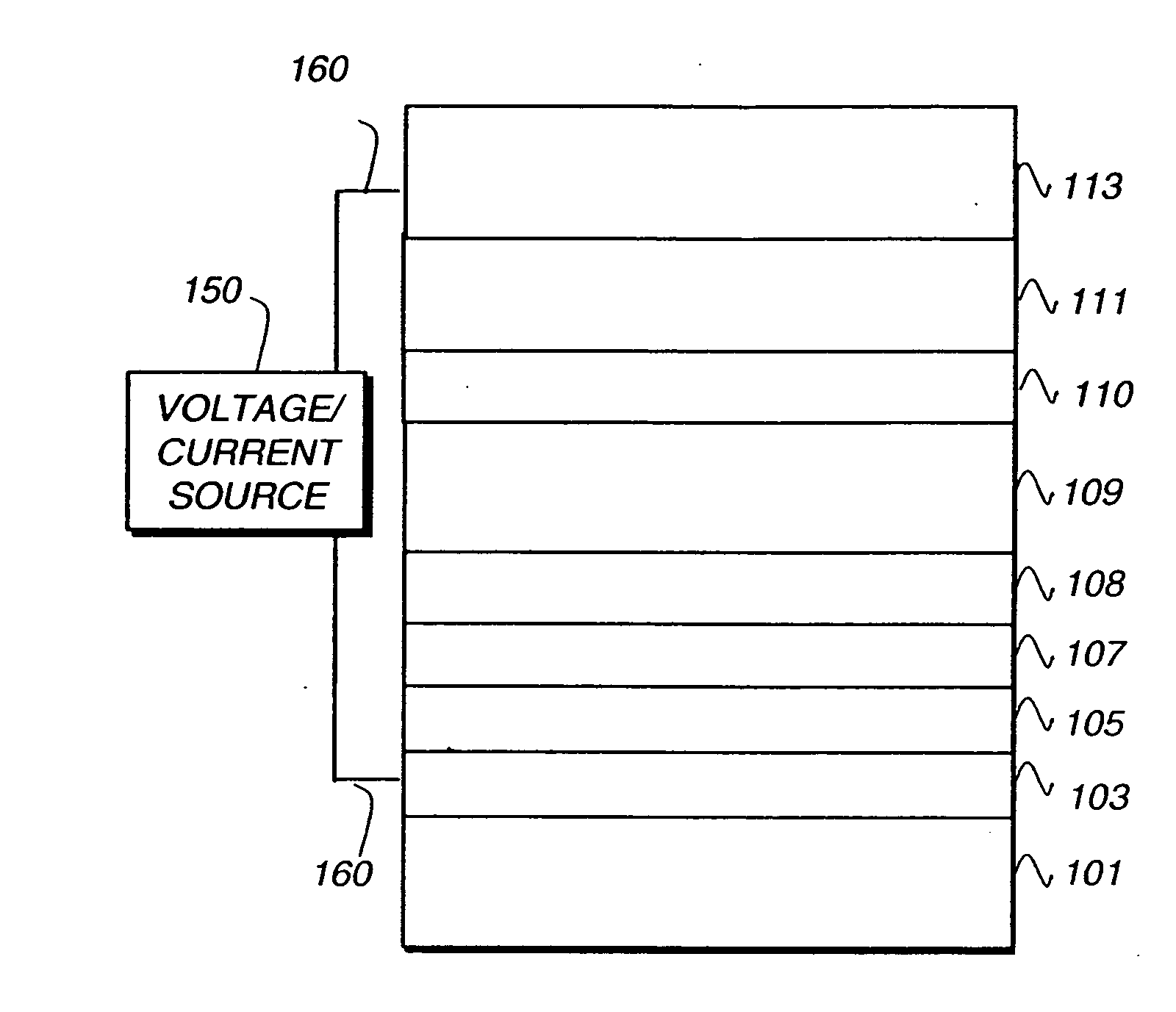Oled devices with dinuclear copper compounds
a technology of dinuclear copper and oled devices, which is applied in the direction of discharge tube luminescnet screens, natural mineral layered products, etc., can solve the problems of large loss of efficiency, material emissivity when irradiated by visible light, and performance limitations that are not suitable for many desirable applications
- Summary
- Abstract
- Description
- Claims
- Application Information
AI Technical Summary
Problems solved by technology
Method used
Image
Examples
example 1
[0284] An EL device (Sample 1) satisfying the requirements of the invention was constructed in the following manner:
[0285] 1. A glass substrate coated with an 85 nm layer of indium-tin oxide (ITO) as the anode was sequentially ultrasonicated in a commercial detergent, rinsed in deionized water, degreased in toluene vapor and exposed to oxygen plasma for about 1 min.
[0286] 2. Over the ITO was deposited a 1 nm fluorocarbon (CFx) hole-injecting layer (HIL) by plasma-assisted deposition of CHF3.
[0287] 3. A hole-transporting layer (HTL)of N,N′-di-1-naphthyl-N,N′-diphenyl-4,4′-diaminobiphenyl (NPB) having a thickness of 75 nm was then evaporated from a tantalum boat.
[0288] 4. A 35 nm light-emitting layer (LEL) of 4,4′-N,N′-dicarbazole-biphenyl (CBP) and Inv-1 (1 wt %) were then deposited onto the hole-transporting layer. These materials were also evaporated from tantalum boats.
[0289] 5. A hole-blocking layer of bis(2-methyl-quinolinolato)(2,4,6-triphenylphenolato)aluminum(III) (Balq)...
example 2
[0294] An EL device (Sample 7) satisfying the requirements of the invention was constructed in the following manner:
[0295] 1. A glass substrate coated with an 85 nm layer of indium-tin oxide (ITO) as the anode was sequentially ultrasonicated in a commercial detergent, rinsed in deionized water, degreased in toluene vapor and exposed to oxygen plasma for about 1 min.
[0296] 2. Over the ITO was deposited a 1 nm fluorocarbon (CFx) hole-injecting layer (HIL) by plasma-assisted deposition of CHF3.
[0297] 3. A hole-transporting layer (HTL) of N,N′-di-1-naphthyl-N,N′-diphenyl-4,4′-diaminobiphenyl (NPB) having a thickness of 95 nm was then evaporated from a tantalum boat.
[0298] 4. A 35 nm light-emitting layer (LEL) of 9,9′-(1,3-phenylene)bis-9H-carbazole (mCP) and Inv-1 (8 wt %) were then deposited onto the hole-transporting layer. These materials were also evaporated from tantalum boats.
[0299] 5. A hole-blocking layer of bis(2-methyl-quinolinolato)(2,4,6-triphenylphenolato)aluminum(III)...
example 3
[0303] An EL device (Sample 8) satisfying the requirements of the invention was constructed in the following manner:
[0304] 1. A glass substrate coated with an 85 nm layer of indium-tin oxide (ITO) as the anode was sequentially ultrasonicated in a commercial detergent, rinsed in deionized water, degreased in toluene vapor and exposed to oxygen plasma for about 1 min.
[0305] 2. Over the ITO was deposited a 1 nm fluorocarbon (CFx) hole-injecting layer (HIL) by plasma-assisted deposition of CHF3.
[0306] 3. A hole-transporting layer (HTL) of N,N′-di-1-naphthyl-N,N′-diphenyl-4,4′-diaminobiphenyl (NPB) having a thickness of 95 nm was then evaporated from a tantalum boat.
[0307] 4. A 35 nm light-emitting layer (LEL) of 4-(9H-carbazol-9-yl)-N,N-bis[4-(9H-carbazol-9-yl)phenyl]-benzenamine (TCTA) and Inv-1 (8 wt %) were then deposited onto the hole-transporting layer. These materials were also evaporated from tantalum boats.
[0308] 5. A hole-blocking layer of bis(2-methyl-quinolinolato)(2,4,6...
PUM
| Property | Measurement | Unit |
|---|---|---|
| wt % | aaaaa | aaaaa |
| triplet energy | aaaaa | aaaaa |
| LUMO energy level | aaaaa | aaaaa |
Abstract
Description
Claims
Application Information
 Login to View More
Login to View More - R&D
- Intellectual Property
- Life Sciences
- Materials
- Tech Scout
- Unparalleled Data Quality
- Higher Quality Content
- 60% Fewer Hallucinations
Browse by: Latest US Patents, China's latest patents, Technical Efficacy Thesaurus, Application Domain, Technology Topic, Popular Technical Reports.
© 2025 PatSnap. All rights reserved.Legal|Privacy policy|Modern Slavery Act Transparency Statement|Sitemap|About US| Contact US: help@patsnap.com



